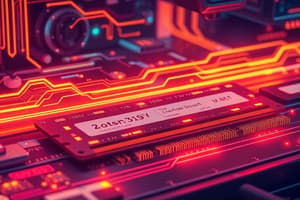Podcast
Questions and Answers
What is the function of cache memory in a computer system?
What is the function of cache memory in a computer system?
- To act as a high-speed buffer between the CPU and main memory (correct)
- To store data and instructions for processing
- To control the flow of data between the computer and external devices
- To provide long-term storage for large amounts of data
Which type of memory is used to store data and instructions in a computer system?
Which type of memory is used to store data and instructions in a computer system?
- Primary Memory (correct)
- Cache Memory
- Virtual Memory
- Secondary Memory
What is the primary function of cache memory?
What is the primary function of cache memory?
- To hold frequently used data and program parts for quick access by the CPU (correct)
- To serve as a long-term storage for large amounts of data
- To provide storage for permanent storage of data and program instructions
- To control the input and output operations of the computer system
What does the term 'word size' refer to in computer memory systems?
What does the term 'word size' refer to in computer memory systems?
Which access method involves starting at the beginning and reading through data in order?
Which access method involves starting at the beginning and reading through data in order?
Where is cache memory located in a computer system?
Where is cache memory located in a computer system?
Which memory type requires refreshing even when powered?
Which memory type requires refreshing even when powered?
What type of memory is typically used for temporary storage?
What type of memory is typically used for temporary storage?
Which type of memory is characterized by storing bits as on/off switches?
Which type of memory is characterized by storing bits as on/off switches?
Which memory type is used for permanent storage?
Which memory type is used for permanent storage?
What type of memory is characterized by needing special equipment to program it?
What type of memory is characterized by needing special equipment to program it?
Which type of memory can be erased by UV light?
Which type of memory can be erased by UV light?
What is the memory cycle time?
What is the memory cycle time?
Which memory type is characterized by smaller per bit storage and needing refreshing circuits?
Which memory type is characterized by smaller per bit storage and needing refreshing circuits?
What is the rate at which data can be moved in a memory unit called?
What is the rate at which data can be moved in a memory unit called?
What is the time it takes to perform a read or write operation called?
What is the time it takes to perform a read or write operation called?
Flashcards are hidden until you start studying
Study Notes
Cache Memory
- Primary function is to act as a buffer between the main memory and CPU, reducing the time it takes to access data
- Located close to the CPU to increase access speed
Memory Types
- Main Memory: stores data and instructions, volatile, and loses data when powered off
- Cache Memory: small, fast, and volatile, used for temporary storage
- ROM (Read-Only Memory): non-volatile, used for permanent storage
- EPROM (Erasable Programmable Read-Only Memory): can be erased by UV light, needs special equipment to program
- DRAM (Dynamic Random Access Memory): requires refreshing circuits, smaller per bit storage
Memory Access and Operations
- Sequential Access: starting at the beginning and reading through data in order
- Memory Cycle Time: the time it takes to perform a read or write operation
- Bandwidth: the rate at which data can be moved in a memory unit
- Word Size: refers to the number of bits that can be processed by the CPU in a single clock cycle
Studying That Suits You
Use AI to generate personalized quizzes and flashcards to suit your learning preferences.




